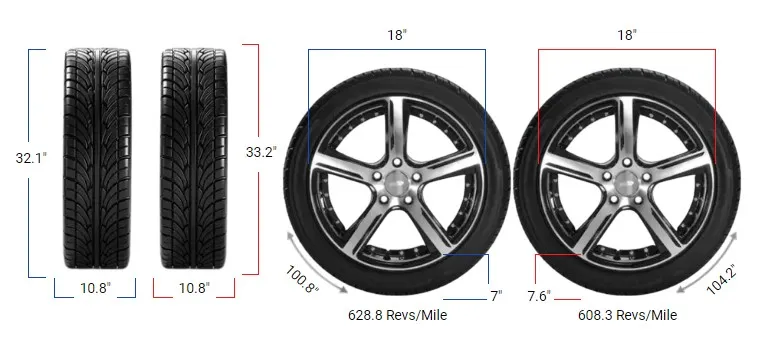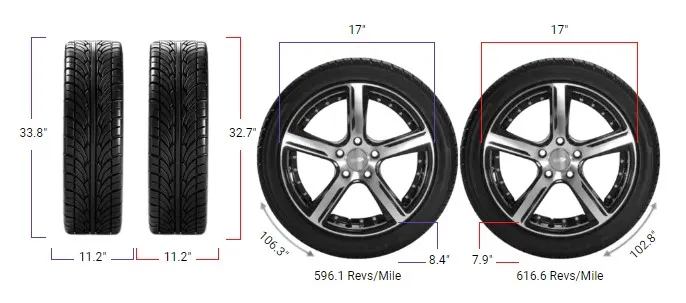Tire Size 205/55r16 vs 205/65r16

Tire upgrades can significantly impact your vehicle’s performance and safety. Let’s explore the effects of switching from 205/55R16 to 205/65R16 tires, examining both the benefits and potential drawbacks.
- Ride comfort may improve due to taller sidewalls
- Fuel efficiency might slightly decrease
- Off-road performance and traction could enhance
- Vehicle aesthetics change with a more robust look
- Tire switch exceeds the recommended 3% size difference

Fitment Guide
It’s crucial to follow the fitment guide. The diameter difference between 205/55R16 and 205/65R16 tires is 6.5%, which exceeds the acceptable 3% range.
As a result, this interchange is not recommended without making necessary adaptations to prevent issues such as rubbing or clearance problems.
On-Road Impact
The switch to larger tires can have significant effects on your vehicle’s on-road performance. Let’s examine how this change impacts various aspects of your driving experience.
- Ground Clearance: The larger 205/65R16 tires increase the vehicle’s ground clearance by approximately 0.8 inches (20.5 mm). This change can be beneficial for navigating over small obstacles or rough road surfaces. However, it may also slightly raise the vehicle’s center of gravity, potentially affecting handling characteristics.
- Gas Mileage: The larger tires have a greater rolling resistance due to their increased size and weight. This can lead to a slight decrease in fuel efficiency, as the engine needs to work harder to maintain the same speed. The impact on gas mileage is typically minimal but may be noticeable over long distances or during city driving with frequent stops and starts.
- Aesthetics: The taller sidewall of the 205/65R16 tires gives the vehicle a more robust and muscular appearance. This change can be particularly appealing for SUVs or crossovers, enhancing their rugged look. However, some drivers may prefer the sportier appearance of the lower-profile 205/55R16 tires.
- Ride Comfort: The taller sidewall of the 205/65R16 tires provides more cushioning, potentially improving ride comfort. This extra rubber can help absorb road imperfections, resulting in a smoother and more comfortable ride, especially on rough or uneven surfaces.
- Speedometer Accuracy: The larger tire diameter affects the vehicle’s speedometer readings. With 205/65R16 tires, the actual speed will be higher than what the speedometer indicates. For example, when the speedometer reads 20 mph (32.19 km/h), the actual speed will be 21.3 mph (34.28 km/h). This 6.5% difference can lead to unintentional speeding if not accounted for.
- Durability & Wear: The taller sidewall of the 205/65R16 tires may offer improved durability, especially when driving on rough roads. The extra rubber can help protect the wheel from impacts and reduce the risk of sidewall damage. However, the larger contact patch may lead to slightly faster wear in some driving conditions.

Off-Road Impact
For those who occasionally venture off the beaten path, the switch to larger tires can have notable effects on off-road performance. Here’s how the change impacts your vehicle’s capabilities in rougher terrain.
- Improved Ground Clearance: The 0.8-inch (20.5 mm) increase in ground clearance provided by the 205/65R16 tires can be significant in off-road situations. This extra height allows the vehicle to clear larger obstacles, reducing the risk of undercarriage damage when driving on uneven terrain or over small rocks.
- Traction: The larger contact patch of the 205/65R16 tires can provide improved traction in loose or soft surfaces like mud, sand, or gravel. This can be particularly beneficial when climbing steep inclines or navigating through challenging off-road conditions.
- Flotation: The wider profile of the 205/65R16 tires offers better flotation on soft surfaces like snow or sand. This can help prevent the vehicle from sinking and getting stuck in these challenging conditions.
- Durability: The taller sidewall of the 205/65R16 tires provides additional protection against punctures and cuts from sharp rocks or other off-road hazards. This improved durability can be valuable when venturing into rough terrain.
- Wheel Protection: The extra sidewall height acts as a buffer between the wheel and obstacles, reducing the risk of wheel damage when driving over rocks or other rough surfaces.

Can I Use 205/65r16 Instead of 205/55r16?
It is not recommended to use 205/65R16 tires instead of 205/55R16 tires. The diameter difference between these two sizes is approximately 6.5%, which is more than the typically advised maximum difference of 3%.
Using 205/65R16 tires in place of 205/55R16 tires could negatively impact vehicle handling, speedometer accuracy, fuel efficiency, and overall performance. It may also be unsafe.
How Much Taller Is a 205/65r16 Tire Than a 205/55r16?
A 205/65R16 tire is 1.61 inches (41 mm) taller than a 205/55R16 tire. The overall diameter of the 205/65R16 tire is 26.49 inches (672.9 mm), while the overall diameter of the 205/55R16 tire is 24.88 inches (631.9 mm).
What is the Difference Between 205/55r16 and 205/65r16?
The primary distinction between 205/55R16 and 205/65R16 tires lies in their overall diameter. The 205/65R16 tire is 1.61 inches (41 mm) larger in diameter, representing a 6.5% increase.
205/55r16 vs 205/65r16 Table
This table allows for an easy comparison between 205/55R16 and 205/65R16 tire sizes.
| Feature | 205/55R16 | 205/65R16 | Difference |
|---|---|---|---|
| Diameter inches (mm) | 24.88 (631.9) | 26.49 (672.9) | 1.61 (41) +6.5% |
| Width inches (mm) | 8.07 (205) | 8.07 (205) | 0 (0) 0% |
| Circumference inches (mm) | 78.16 (1985.17) | 83.23 (2113.98) | 5.07 (128.81) +6.5% |
| Sidewall Height inches (mm) | 4.44 (112.75) | 5.25 (133.25) | 0.81 (20.5) +18.2% |
| Revolutions per mile (km) | 810.68 (503.73) | 761.29 (473.04) | -49.4 (-30.69) -6.1% |
| Speedo Reading | 20 mph | 21.3 mph | +1.3 mph |
Our Observation
Switching from 205/55R16 to 205/65R16 tires offers both benefits and drawbacks. The larger tires provide improved ground clearance, better ride comfort, and enhanced off-road capabilities.
However, they may slightly reduce fuel efficiency and affect speedometer accuracy. The impact on on-road performance is generally minimal, with the most noticeable changes being in aesthetics and ride quality.
Off-road, the larger tires offer significant advantages in terms of clearance and traction. While the 6.5% size difference exceeds the recommended 3% limit, many drivers find the benefits outweigh the drawbacks, especially for vehicles used in diverse driving conditions.

Caitlin McCormack is a lead writer at Tiresizecompare.com and a trusted guide at AmarCalculator. With an extensive background in finance and mathematics, she simplifies complex calculations and delivers precise insights. Caitlin’s expertise ensures readers receive accurate and reliable information to make informed decisions. Her passion for numbers and dedication to clarity make her an invaluable resource for tire comparisons.


